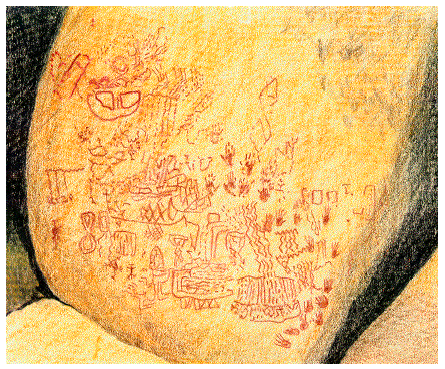PICTOGRAPHS: LUISENO
|
|
|
Pictographs
painted with red hematite on rocks were made by Luiseno girls and boys during their puberty ceremony. The hand prints may have been like a signature of those who were part of the ceremony. Diamond and zig zag patterns probably represent the rattlesnake, the girls' guardian spirit. This site is not open to the public. It is near Perris, Riverside County, California.
Redrawn image by Sue Ann Sinay from a photograph by D. McCarthy.
|
PICTOGRAPHS: LUISENO
ARCHEOLOGICAL EXHIBITS AND MUSEUMS
|
Riverside Municipal Museum.
Riverside, CA
|
The Bowers Museum.
Santa Ana, CA
|
Southwest Museum.
Los Angeles, CA
|
ROCK ART SITES
|
Mockingbird Canyon County Park.
contact: Riverside County Parks Dept., Riverside, CA
|
Idyllwild County Park.
contact: Riverside County Parks Dept., Idyllwild, CA
|
Lake Perris State Recreation Area.
contact: Park Office, Perris, CA
|
The Luiseno occupied present day Orange County from Aliso Creek south to Oceanside and inland to Temecula and Mt. Palomar. Their name derives from the San Luis Rey Mission, where they were taken during the Spanish occupation of California. They spoke a dialect of the Shoshonean language. Their life style was similar to the other Native Americans in Southern California during the pre-contact period.
Villages were located in sheltered canyons or near year-round fresh water. Some villages were located in the mountains, some in the foothills, others were located along the coast. Villages were made up of family members and relatives. The chiefs of the village inherited their rank. Each village owned its own land and was located near food supplies.
They ate wild game, fish, acorns, and seeds from a variety of plants. Many of the Natives living along the coast in Southern California did not make pottery. However, about A.D.1650 the Luiseno began to make pottery. Many of their utensils were made of bone, stone, and wood. Cooking was done with hot rocks dropped into pottery vessels, or soapstone bowls, or even into baskets which were woven so closely that they were water tight. Both the men and women shared in the hunting and gathering of food.
Since the climate was mild, little clothing was needed. Luiseno men wore nothing but a net belt for carrying things. In cold weather they wore a twined fur blanket. The women wore a two-part skirt. They also wore a woven basketry cap when carrying loads with a trump line over their forehead. Older women stayed in the villages to take care of the children.
Houses were built over a pit about two feet deep. In the mountains the roof was made of cedar bark. Stems of grasses were used for roofs in the lower elevations, and tule and sedges were used in the coastal areas. The roof was then also covered with earth. A smoke hole in the roof ventilated the central fireplace. Entry was through a door or sometimes a short tunnel. Sweat houses were used by the men in the evenings.
The ceremonial area was a round enclosure encircled by a fence. A smaller enclosure for the dressing of dancers was off to the side. Men performed the rituals, and women prepared the ceremonial food.
Boys and girls participated in puberty ceremonies when they reached adolescence. They were taught about the supernatural powers and taboos, to be respectful and polite to their elders, to refrain from anger, and the consequences of wrong behavior. During the ceremonies, sand paintings were created to illustrate the Luiseno conception of the universe, the night sky with the Milky Way, sacred beings, and the spiritual component of the human personality. At the end of the puberty ceremony the sand paintings were destroyed. Girls raced to a rock where they painted angular and diamond shaped designs. Some of the rock paintings can still be seen today. This style of painted rock art is called San Luis Rey Style by Ken Hedges of The Museum of Man in San Diego.
The first sites to be described in the 1950's were located along the San Luis Rey River in northern San Diego County. According to Hedges, "This style is characterized by geometric rectilinear design elements in red, including diamonds, zigzags, chevrons, straight lines, and dot patterns often arranged in vertical series which frequently are bordered at top and/or bottom. Representational elements (such as animals, anthropomorphs, hand prints, and sunbursts) and curvilinear elements (such as circles, concentric circles, and spirals) are present but rare."
Source:
Handbook of the Indians of California
, A.L. Kroeber, Dover, New York,1976; and from:
California Indians
, George Emanuels, Diablo Books, Walnut Creek, CA. 1991; and from: "Rock Art Styles In Southern California," Ken Hedges, 1990.
Go to contents page | Go to previous section | Go to next section
